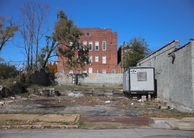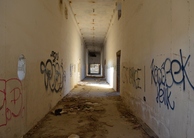|
Featured Article: Out in Force: The New Struggle Against Sexually Oriented Policing
Aguilera’s military rationale makes sense, as heterosexual norms such as aggression are reinforced, though he argued his policing style is more passive than aggressive. The lack of training Aguilera received on how to deal with certain populations, especially GLBT members, has made it difficult for him to be sensitive in such cases as well. Additionally, Aguilera grew up in a closed, crime infested and homophobic neighborhood in Prince George’s County, Maryland. For this reason, contact with members of the GLBT community still makes Aguilera a little uneasy because he perceives GLBT culture as flamboyant and “abnormal.” However, his experiences with individuals from the community who defy his perceptions have slowly started to change his notions of the GLBT community.
In fact, Aguilera even positively discussed Metro PD’s Gay and Lesbian Liaison Unit (GLLU). The GLLU is staffed by openly LGBT members of the department and their allies (GLLU 2011). The GLLU, which began in 2009, advises the Chief of Police on issues surrounding the LGBT community while focusing on providing 24-hour police response to members of the GLBT communities and MPD. The GLLU also produces reports on LGBT violence and crime to help promulgate and make the issue prominent within the media and abroad to all. It also offers specified services to members. Nationally and internationally, there are 11 recognized LGBT units.
While the GLBT community still faces many challenges within departments and Paulson (2008) suggests that heterosexist values have been built into the laws, GLBT issues have started to gain national recognition due to the strong gay rights movement. The landmark Supreme Court case Lawrence v. Texas (2003) invalidated the criminalization of sodomy for consenting heterosexual and homosexual couples in 14 states. The decision in Lawrence shed light on sexual privacy as a constitutional right, especially for the GLBT community. Before Lawrence, police could barge into homes if they had reasonable cause to believe sodomy was occurring. Lawrence has also led other states to enact legislation against anti-sodomy laws.
Currently, twenty states, D.C. and 140 cities and counties have laws prohibiting discrimination (i.e. in housing, employment and public accommodation) on the basis of sexual orientation (Newton 2009), which has increased public goods and services to the LGBT community over the last five years (National Gay and Lesbian Task Force 2008). Some courts have even taken matters into their hands, ruling in favor of LGBT employment rights (Buhrke 1996). However, the absence of federal legislation makes the issue more difficult to solve. Some states still have the ability to create laws directly against same sex couples and LGBT rights. Five states exclude same sex victims of domestic crime, for example, from provisions that support the issuance of protective orders. However, the repeal of policies such as Don’t Ask, Don’t Tell provides a foundation for possible national legislation.
The ongoing formation and creation of completely LGBT friendly police associations has begun to challenge the heterosexist culture that once dominated departments (Burke 1994, 1996). Because police culture is still somewhat based on gender biases, more departments will need to consider creating such LGBT friendly police associations to address problems of the community and collate research for police to use. This will help break down social barriers within police departments so they apply these practices during policing. These GLBT friendly associations must also have a racially diverse staff to address problems particular to all types of GLBT individuals as well.
Aguilera, L. (2011). Second District Metropolitan Police Department. Interview. Retrieved from: http://mpdc.dc.gov/mpdc/cwp/view,a,1239,q,544652,mpdcNav_GID,1535.asp
Barlow, D. E. & Barlow, M. H. (2000). Police in a multicultural society: An American story. Prospect Heights, IL: Waveland Press, Inc.
Berrill, Kevin T. (1992). Anti-gay violence and victimization in the United States: An overview. In Hate crimes: Confronting violence against lesbians and gay men, edited by Gregory Herek and Kevin Berrill, 19-45. Newbury Park, CA: Sage.
Bernstein, M. (2004). Paths to homophobia. Sexuality Research & Social Policy, 1, 41-55.
Brantner, P. A. (1992). Removing bricks from a wall of discrimination: State constitutional challenges to sodomy laws. Hastings Constitutional Law Quarterly, 19, 495-533.
Buhrke, Robin A. (1996). A matter of justice: Lesbians and gay men in law enforcement. NewYork: Routledge.
Cohen, R., O’Byrne, S., & Maxwell, P. (1999). Employment discrimination based on sexual orientation: The American, Canadian and UK responses. Law & Inequity, 17 (1), 1-20.
Colvin, R. (2008.) Shared Perceptions Among Lesbian and Gay Police Officers: Barriers and Opportunities in the Law Enforcement Work Environment. Police Quarterly. 12, 86-101.
Cooper, C., Dunham, R.G., Alpert, G.P. (2010). “An Afrocentric Perspective on Policing.” Critical Issues in Policing. Long Grove, IL: Waveland Press, Inc. 362-387.
Cook-Daniels, L. (1998). Lesbian, Gay, Male, Bisexual and Transgendered Elders: Neglect Issues. Journal of Elder Abuse and Neglect, 9 (2), 35-49.
David, D., Brannon, R. (1976). The forty-nine percent majority: The male sex role. Reading, MA: Addison/Wesley.
Doss, M. T., Jr. 1990. Police management: Sexual misconduct and the right to privacy. Journal of Police Science and Administration 17 (3): 194-204.
Dwyer, A. E. (2011). Policing lesbian, gay, bisexual and transgender young people: a gap in the research literature. Current Issues in Criminal Justice, 22 (3), pp. 415-433.
Dwyer, A.E. (2009). Identifiable, queer and risky: the role of the body in policing experiences for LGBT young people. In: Proceedings of the 2009 Australian and New Zealand Critical Criminology Conference, 8-9 July 2009, Melbourne, Victoria.
Dwyer, A.E. (2007). Visibly invisible: Policing queer young people as a research gap. In Curtis, Bruce, Eds. Proceedings Public Sociologies: Lessons and Trans-Tasman Comparisons, TASA & SAANZ Joint Conference, Auckland, New Zealand.
Gay and Lesbian Liaison Unit, Washington DC Metropolitan Police Department (2011). “Welcome.” Retrieved at: http://www.gllu.org/index.htm
Grant, J.M., Mottet, L.A., Tanis, J. (2011). Injustice at Every Turn: A Report of the National Transgender Discrimination Survey. Washington: National Center for Transgender Equality and National Gay and Lesbian Task Force, 2011.
Gibson, P. (1989). Gay male and lesbian youth suicide, vol 3: preventions and interventions in youth suicide. In report of the secretary’s task force on youth suicide. Rockville, MD: US Department of Health and Human Services.
Herek, G. M. (2000). Sexual prejudice and sex: Do heterosexuals' attitudes toward lesbians and gay men differ? Journal of Social Issues, 56, 251-266.
Herek, G. M. (2003a). The psychology of sexual prejudice. In L.D. Garnets & D. C.
Kimmel (Eds.), Psychological perspectives on lesbian, gay, and bisexual experiences (2n ed., pp. 157-164). New York: Columbia University Press.
Herek, G. M. (2003b). Why tell if you're not asked? In L.D. Garnets & D. C. Kimmel (Eds.), Psychological perspectives on lesbian, gay, and bisexual experiences (2n ed., pp. 270-298). New York: Columbia University Press.
Jung, P.B., Smith, R. F. (1993). Heterosexism: An Ethical Challenge. State University of New York Press.
Lyons, P.M., DeValve, M.J., Garner, R.L. (2008). Texas Chiefs’ Attitudes Toward Gay and Lesbian Police Officers. Police Quarterly, 11 (1), 102-117.
Martin, Susan E. (1980). Breaking and entering: Policewomen on patrol. Berkeley: University of California Press.
Messerschmidt, J. (1993). Masculinities and crime: Critique and reconceptualization of theory. Lanham, MD: Rowan & Littlefield.
Miller, S.L., Forest, K.B., Jurik, N.C. (2003). Diversity in Blue: Lesbian and Gay Police Officers in a Masculine Occupation. Men and Masculinities. 5 (4), 355-385.
Miller, Susan L. (1999). Gender and community policing: Walking the talk. Boston: Northeastern University Press.
Myers, K.A., Forest, K.B., Miller, S.L. (2004). Officer Friendly and the Tough Cop: Gays and Lesbians Navigate Homophobia and Policing. Journal of Homosexuality, 47 (1), pp. 17-37.
National Gay and Lesbian Task Force. (2008). State nondiscrimination laws in the U.S. Retrieved October 17, 2008, from http://www.thetaskforce.org/downloads/reports/issue_maps/non_discrimination_7_08 .pdf
Newton, D.E. (2009). Gay and Lesbian Rights. Santa Barbara, CA: Greenwood Publishing Group.
Paulson, A.A. (2008). Perceptions of Same Sex and Opposite Sex Interpersonal Violence: A Comparison of Psychologists and Law Enforcement Personnel. 1-177.
People for the American Way Foundation. (1998, August 18). Religious right’s hate tactics documented in hostile climate: 1998 edition. Retrieved from: http://www.pfaw.org/pfaw/general/default.aspx?oid=14538
Potoczniak, M. J., Mourot, J. E., Crosbie-Burnett, M., & Potoczniak, D. J. (2003). Legal and psychological perspectives on same-sex domestic violence: A multi-systemic approach. Journal of Family Psychology, 17, 252-259.
Ray, N. (2006). Lesbian, gay, bisexual and transgender youth: an epidemic of homelessness. New York: National Gay and Lesbian Task Force Policy Institute and the National Coalition for the Homeless.
Ritchie, A.J., Mogul, J.L., Whitlock, K. (2011). “Gleeful Gay Killers, Lethal Lesbians, and Deceptive Gender Benders.” Queer (In) justice: The Criminalization of LGBT People in the United States. Boston, MA: Beacon Press Books. pp. 20-45.
Schulz, D. M. (1995). From social worker to crime fighter: Women in United States municipal policing. New York: Praeger.
Sklansky, D. (2006). Not your father’s police department: Making sense of the new demographics of law enforcement. Journal of Criminal Law and Criminal, 96, 1209-1243.
Squatriglia, H. (2007). Lesbian, Gay, Bisexual and Transgender Youth in the Juvenile Justice System: Incorporating Sexual Orientation and Gender Identity into the Rehabilitative Process. 793-817.
Wallace, H. (2008). Family Violence: Legal, Medical, and Social Perspectives, Fifth Edition. Pearson Education.
- Fridell, Scott, Dunham, Alpert (2010).
- Cook-Daniels (1998). Sexual Orientation: Refers to whom someone is sexually and/or emotionally attracted to: someone of the same gender (lesbian, gay male, gay or homosexual, as well as someone of the opposite gender (heterosexual or ‘straight’); or both (bisexual)
- Cook-Daniels (1998). Transgender: The state of one’s own “gender identity” (self identification as woman, man neither or both) not matching one’s “assigned sex.”
- Cook-Daniels (1998). Gender: Refers to whether you perceive yourself to be male, female both or neither. Associates being male with masculine traits, and female with feminine traits.
- Miller, Forest, Jurik (2003).
- Jung, Smith (1993)
- Miller, Forest, Jurik (2003)
- Messerschmidt (1993)
- Colvin (2008)
- Colvin (2008)
- Authoritarianism: A form of social organization characterized by submission to authority.
- Miller, Forest, Jurik (2003)
- Lyons, DeValve, Garner (2008)
- Lyons, DeValve, Garner (2008)
- Aguilera, Interview. (2011).
- Aguilera, Interview. (2011).
- Aguilera, Interview. (2011).
- Aguilera, Interview. (2011).
- Maneen, Dunham, Alpert (2011). The “asshole”: The bigmouth, creep, bastard, animal, “shit head” fool who give police more trouble than needed.
- Dunham, Alpert (2011).
- Wallace (2008). Domestic violence dispute: Usually a call to police from a member of a family or closely related group of people that they have been hurt or abused by someone within a household or close in relation to them. Usually associated between a man and a woman.
- Paulson (2008).
- Paulson (2008). Interpersonal violence/SSIPV/OPISV: Usually violence between members of the same or opposite sex. The term is typically applied to identify those members who are part of the GLBT community though.
- 24.) Aguilera, Interview. (2011).
- “About” GLLU (2011).
- Atlanta PD, Ottawa (Canada), Arlington County, Baltimore City, Fairfax County, Fargo PD (North Dakota); NYPD; New Zealand PD; Richland County (South Carolina) Sheriff’s Dept; Toronto Police Service (Canada); DC Metro Transit PD
- 539 U.S. 558 (2003)
- Alabama, Florida, Idaho, Kansas, Louisiana, Michigan, Mississippi, Missouri, North Carolina, South Carolina, Texas, Utah, an Virginia
- Delaware, South Carolina, Montana, New York and Virginia
Aguilera, L. (2011). Second District Metropolitan Police Department. Interview. Retrieved from: http://mpdc.dc.gov/mpdc/cwp/view,a,1239,q,544652,mpdcNav_GID,1535.asp
Barlow, D. E. & Barlow, M. H. (2000). Police in a multicultural society: An American story. Prospect Heights, IL: Waveland Press, Inc.
Berrill, Kevin T. (1992). Anti-gay violence and victimization in the United States: An overview. In Hate crimes: Confronting violence against lesbians and gay men, edited by Gregory Herek and Kevin Berrill, 19-45. Newbury Park, CA: Sage.
Bernstein, M. (2004). Paths to homophobia. Sexuality Research & Social Policy, 1, 41-55.
Brantner, P. A. (1992). Removing bricks from a wall of discrimination: State constitutional challenges to sodomy laws. Hastings Constitutional Law Quarterly, 19, 495-533.
Buhrke, Robin A. (1996). A matter of justice: Lesbians and gay men in law enforcement. NewYork: Routledge.
Cohen, R., O’Byrne, S., & Maxwell, P. (1999). Employment discrimination based on sexual orientation: The American, Canadian and UK responses. Law & Inequity, 17 (1), 1-20.
Colvin, R. (2008.) Shared Perceptions Among Lesbian and Gay Police Officers: Barriers and Opportunities in the Law Enforcement Work Environment. Police Quarterly. 12, 86-101.
Cooper, C., Dunham, R.G., Alpert, G.P. (2010). “An Afrocentric Perspective on Policing.” Critical Issues in Policing. Long Grove, IL: Waveland Press, Inc. 362-387.
Cook-Daniels, L. (1998). Lesbian, Gay, Male, Bisexual and Transgendered Elders: Neglect Issues. Journal of Elder Abuse and Neglect, 9 (2), 35-49.
David, D., Brannon, R. (1976). The forty-nine percent majority: The male sex role. Reading, MA: Addison/Wesley.
Doss, M. T., Jr. 1990. Police management: Sexual misconduct and the right to privacy. Journal of Police Science and Administration 17 (3): 194-204.
Dwyer, A. E. (2011). Policing lesbian, gay, bisexual and transgender young people: a gap in the research literature. Current Issues in Criminal Justice, 22 (3), pp. 415-433.
Dwyer, A.E. (2009). Identifiable, queer and risky: the role of the body in policing experiences for LGBT young people. In: Proceedings of the 2009 Australian and New Zealand Critical Criminology Conference, 8-9 July 2009, Melbourne, Victoria.
Dwyer, A.E. (2007). Visibly invisible: Policing queer young people as a research gap. In Curtis, Bruce, Eds. Proceedings Public Sociologies: Lessons and Trans-Tasman Comparisons, TASA & SAANZ Joint Conference, Auckland, New Zealand.
Gay and Lesbian Liaison Unit, Washington DC Metropolitan Police Department (2011). “Welcome.” Retrieved at: http://www.gllu.org/index.htm
Grant, J.M., Mottet, L.A., Tanis, J. (2011). Injustice at Every Turn: A Report of the National Transgender Discrimination Survey. Washington: National Center for Transgender Equality and National Gay and Lesbian Task Force, 2011.
Gibson, P. (1989). Gay male and lesbian youth suicide, vol 3: preventions and interventions in youth suicide. In report of the secretary’s task force on youth suicide. Rockville, MD: US Department of Health and Human Services.
Herek, G. M. (2000). Sexual prejudice and sex: Do heterosexuals' attitudes toward lesbians and gay men differ? Journal of Social Issues, 56, 251-266.
Herek, G. M. (2003a). The psychology of sexual prejudice. In L.D. Garnets & D. C.
Kimmel (Eds.), Psychological perspectives on lesbian, gay, and bisexual experiences (2n ed., pp. 157-164). New York: Columbia University Press.
Herek, G. M. (2003b). Why tell if you're not asked? In L.D. Garnets & D. C. Kimmel (Eds.), Psychological perspectives on lesbian, gay, and bisexual experiences (2n ed., pp. 270-298). New York: Columbia University Press.
Jung, P.B., Smith, R. F. (1993). Heterosexism: An Ethical Challenge. State University of New York Press.
Lyons, P.M., DeValve, M.J., Garner, R.L. (2008). Texas Chiefs’ Attitudes Toward Gay and Lesbian Police Officers. Police Quarterly, 11 (1), 102-117.
Martin, Susan E. (1980). Breaking and entering: Policewomen on patrol. Berkeley: University of California Press.
Messerschmidt, J. (1993). Masculinities and crime: Critique and reconceptualization of theory. Lanham, MD: Rowan & Littlefield.
Miller, S.L., Forest, K.B., Jurik, N.C. (2003). Diversity in Blue: Lesbian and Gay Police Officers in a Masculine Occupation. Men and Masculinities. 5 (4), 355-385.
Miller, Susan L. (1999). Gender and community policing: Walking the talk. Boston: Northeastern University Press.
Myers, K.A., Forest, K.B., Miller, S.L. (2004). Officer Friendly and the Tough Cop: Gays and Lesbians Navigate Homophobia and Policing. Journal of Homosexuality, 47 (1), pp. 17-37.
National Gay and Lesbian Task Force. (2008). State nondiscrimination laws in the U.S. Retrieved October 17, 2008, from http://www.thetaskforce.org/downloads/reports/issue_maps/non_discrimination_7_08 .pdf
Newton, D.E. (2009). Gay and Lesbian Rights. Santa Barbara, CA: Greenwood Publishing Group.
Paulson, A.A. (2008). Perceptions of Same Sex and Opposite Sex Interpersonal Violence: A Comparison of Psychologists and Law Enforcement Personnel. 1-177.
People for the American Way Foundation. (1998, August 18). Religious right’s hate tactics documented in hostile climate: 1998 edition. Retrieved from: http://www.pfaw.org/pfaw/general/default.aspx?oid=14538
Potoczniak, M. J., Mourot, J. E., Crosbie-Burnett, M., & Potoczniak, D. J. (2003). Legal and psychological perspectives on same-sex domestic violence: A multi-systemic approach. Journal of Family Psychology, 17, 252-259.
Ray, N. (2006). Lesbian, gay, bisexual and transgender youth: an epidemic of homelessness. New York: National Gay and Lesbian Task Force Policy Institute and the National Coalition for the Homeless.
Ritchie, A.J., Mogul, J.L., Whitlock, K. (2011). “Gleeful Gay Killers, Lethal Lesbians, and Deceptive Gender Benders.” Queer (In) justice: The Criminalization of LGBT People in the United States. Boston, MA: Beacon Press Books. pp. 20-45.
Schulz, D. M. (1995). From social worker to crime fighter: Women in United States municipal policing. New York: Praeger.
Sklansky, D. (2006). Not your father’s police department: Making sense of the new demographics of law enforcement. Journal of Criminal Law and Criminal, 96, 1209-1243.
Squatriglia, H. (2007). Lesbian, Gay, Bisexual and Transgender Youth in the Juvenile Justice System: Incorporating Sexual Orientation and Gender Identity into the Rehabilitative Process. 793-817.
Wallace, H. (2008). Family Violence: Legal, Medical, and Social Perspectives, Fifth Edition. Pearson Education.
Endnotes
- Fridell, Scott, Dunham, Alpert (2010).
- Cook-Daniels (1998). Sexual Orientation: Refers to whom someone is sexually and/or emotionally attracted to: someone of the same gender (lesbian, gay male, gay or homosexual, as well as someone of the opposite gender (heterosexual or ‘straight’); or both (bisexual)
- Cook-Daniels (1998). Transgender: The state of one’s own “gender identity” (self identification as woman, man neither or both) not matching one’s “assigned sex.”
- Cook-Daniels (1998). Gender: Refers to whether you perceive yourself to be male, female both or neither. Associates being male with masculine traits, and female with feminine traits.
- Miller, Forest, Jurik (2003).
- Jung, Smith (1993)
- Miller, Forest, Jurik (2003)
- Messerschmidt (1993)
- Colvin (2008)
- Colvin (2008)
- Authoritarianism: A form of social organization characterized by submission to authority.
- Miller, Forest, Jurik (2003)
- Lyons, DeValve, Garner (2008)
- Lyons, DeValve, Garner (2008)
- Aguilera, Interview. (2011).
- Aguilera, Interview. (2011).
- Aguilera, Interview. (2011).
- Aguilera, Interview. (2011).
- Maneen, Dunham, Alpert (2011). The “asshole”: The bigmouth, creep, bastard, animal, “shit head” fool who give police more trouble than needed.
- Dunham, Alpert (2011).
- Wallace (2008). Domestic violence dispute: Usually a call to police from a member of a family or closely related group of people that they have been hurt or abused by someone within a household or close in relation to them. Usually associated between a man and a woman.
- Paulson (2008).
- Paulson (2008). Interpersonal violence/SSIPV/OPISV: Usually violence between members of the same or opposite sex. The term is typically applied to identify those members who are part of the GLBT community though.
- 24.) Aguilera, Interview. (2011).
- “About” GLLU (2011).
- Atlanta PD, Ottawa (Canada), Arlington County, Baltimore City, Fairfax County, Fargo PD (North Dakota); NYPD; New Zealand PD; Richland County (South Carolina) Sheriff’s Dept; Toronto Police Service (Canada); DC Metro Transit PD
- 539 U.S. 558 (2003)
- Alabama, Florida, Idaho, Kansas, Louisiana, Michigan, Mississippi, Missouri, North Carolina, South Carolina, Texas, Utah, an Virginia
- Delaware, South Carolina, Montana, New York and Virginia
Suggested Reading from Inquiries Journal
South Korea does not have a strong and visible lesbian, gay, bisexual, transgender social movement in the public, despite active issue advocacy organizations, political representation from the Democratic Labour Party, and popular television shows that portray LGBT characters and themes.1 The LGBT movement has had a difficult time... MORE»
The question of how to lower crime rates has baffled criminologists and law enforcement officials for decades. Over the years, many different models were developed to attempt to lower crime rates. In 1979, Herman Goldstein published an article outlining a revolutionary crime fighting model. This new method was called problem-oriented... MORE»
Ever since its elimination from the list of mental illnesses in 2001, and decriminalization in 1997, homosexuality in China continues to be at the forefront of China’s growing human rights debate. The estimated 40 million lesbian, gay, bisexual, or transgendered (LGBT) Chinese[1] are victims of violence or discrimination both... MORE»
A faceless speaker cries out in a crowded square. Around him is an uneven cacophony produced by an undefined group of people. Fires crackle, smoke soars, and skies blacken. These masses rush frantically toward a new world order beckoning lustfully, greedily with open arms. They rush toward a vision of a new Ukraine–a European... MORE»
Latest in Criminology & Criminal Justice
2019, Vol. 11 No. 01
While media coverage and politicians constantly acknowledge the inadequacies of the criminal justice system in managing victims and offenders of color and low socioeconomic status, the discussion about the failure of the criminal justice system... Read Article »
2018, Vol. 10 No. 01
This paper analyzes the ongoing drug war being waged between Mexican drug trafficking organizations (DTOs), their rivals, and the U.S./Mexican governments. This analysis is conducted through the lens of drug control; namely, through an examination... Read Article »
2011, Vol. 3 No. 01
The search for the criminal personality or super trait has captured both the minds and imaginations of academics and the wider community (Caspi et al., 1994). Partly, this is due to a stubborn aversion to the notion that normal, regular people rape... Read Article »
2015, Vol. 5 No. 1
Organized crime and terrorist organizations cannot be battled by force alone; anti-money laundering (AML) techniques have become key tools to trace these individuals through their finances. Every country has an interest in implementing internationally... Read Article »
2016, Vol. 6 No. 2
This paper explores the role of public institutions in reducing or fostering neighborhood violence and crime. Understanding institutional density as a neighborhood effect, this paper examines how ten public institutions and structures influence... Read Article »
2016, Vol. 8 No. 07
Heroin use and the consequences that come from it are skyrocketing around the United States. From major metropolitan areas to rural towns, millions of people are in the throes of opiate addiction. The traditional response to the illegal use and... Read Article »
2016, Vol. 3 No. 1
It is generally accepted among researchers that incidence of crime is on average higher around vacant and abandoned properties because they can serve as safe havens for criminal activity. However, there has been little research investigating the... Read Article »
|



















